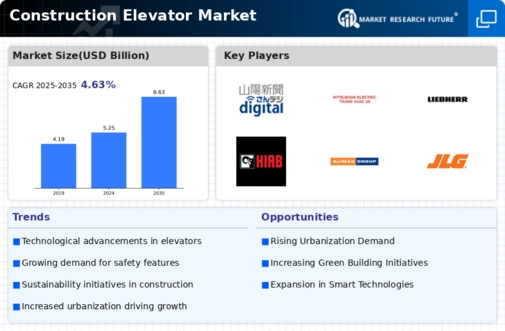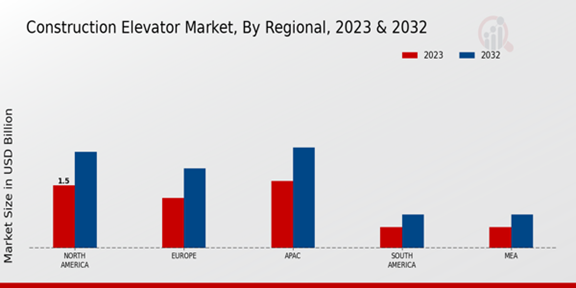Technological Advancements
Technological innovations play a crucial role in shaping the Global Construction Elevator Market Industry. The integration of smart technologies, such as IoT and AI, enhances the efficiency and safety of construction elevators. These advancements allow for real-time monitoring and predictive maintenance, which can reduce downtime and operational costs. As the industry evolves, manufacturers are likely to adopt these technologies to meet the increasing expectations of builders and contractors. The push for automation and improved energy efficiency aligns with global sustainability goals, potentially attracting investments and driving market growth.
Global Economic Growth and Investment
The overall economic growth and increased investment in construction projects are pivotal drivers of the Global Construction Elevator Market Industry. As economies expand, there is a corresponding rise in construction activities, particularly in emerging markets. This growth is reflected in the projected CAGR of 4.62% from 2025 to 2035, indicating a robust demand for construction elevators. Investments in residential, commercial, and industrial sectors are likely to fuel the need for efficient vertical transportation solutions. Consequently, construction elevator manufacturers are poised to benefit from this upward trend, positioning themselves strategically to capture market share.
Regulatory Standards and Safety Regulations
The Global Construction Elevator Market Industry is significantly influenced by stringent regulatory standards and safety regulations. Governments worldwide are implementing more rigorous safety protocols to ensure the well-being of construction workers and the public. Compliance with these regulations often necessitates the use of advanced construction elevators that meet specific safety criteria. As a result, manufacturers are compelled to innovate and enhance their products to align with these standards. This trend not only boosts the demand for compliant construction elevators but also fosters a competitive market environment, encouraging continuous improvement and innovation.
Urbanization and Infrastructure Development
The rapid pace of urbanization globally is a primary driver of the Global Construction Elevator Market Industry. As cities expand, the demand for high-rise buildings increases, necessitating efficient vertical transportation solutions. In 2024, the market is projected to reach 5.25 USD Billion, reflecting the growing need for construction elevators in urban centers. Governments are investing heavily in infrastructure projects, which further propels the demand for construction elevators. For instance, initiatives in developing nations aim to modernize urban landscapes, thereby creating opportunities for construction elevator manufacturers to cater to this burgeoning market.
Rising Demand for Energy-Efficient Solutions
The increasing emphasis on sustainability and energy efficiency is reshaping the Global Construction Elevator Market Industry. Builders and developers are increasingly seeking energy-efficient construction elevators that minimize environmental impact while optimizing performance. This trend is likely to be driven by both regulatory requirements and consumer preferences for greener buildings. As the market evolves, it is expected that energy-efficient solutions will become a standard offering, potentially leading to a market value of 8.63 USD Billion by 2035. This shift not only addresses environmental concerns but also aligns with global initiatives aimed at reducing carbon footprints.























Leave a Comment